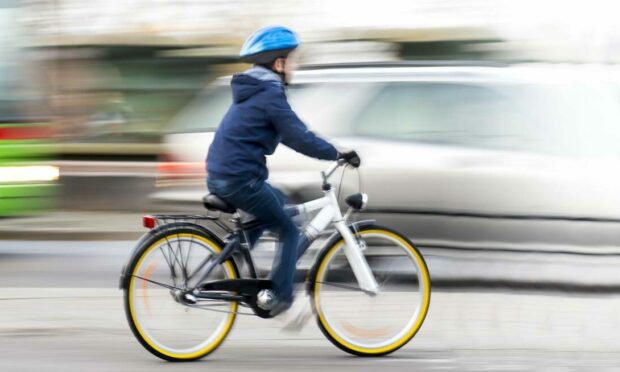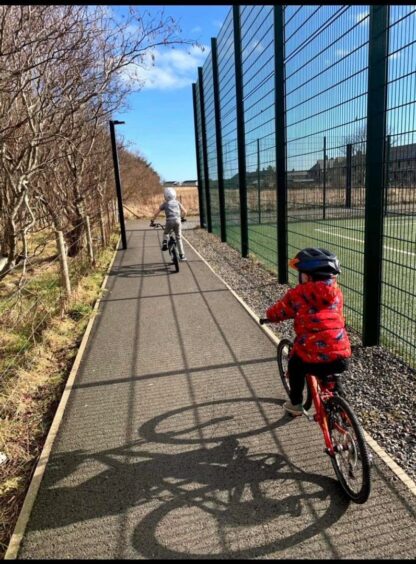Highland Council is considering providing bikes and safety training to encourage cycling to school.
It’s part of a range of proposed changes to the council’s school transport policy.
It’s greener, healthier and possibly more fun – but is it practical?
We spoke to some parents to see what they think about the plans.
And we’d also like you to have your say in our poll below.
What are the details?
Consultants TAS suggested the Highland Council could explore a school cycling plan to offer a greener – and cheaper – alternative to school transport.
The proposal is to give out bikes and safety equipment to pupils who are eligible for the school bus. The council could also provide Bikeability training and work to develop safe cycling routes to schools.
E-bikes could also be offered, though TAS suggests this would be best for pupils aged 14 and over.
The council currently provides school transport to 9,000 pupils at a cost of £331 each.
Initially the scheme would focus on pupils living far enough away to get the school bus. TAS suggests a business case could also be made for pupils living closer to school.
But will it work?
Parents say this is not a quick fix solution.
Eleanor Carlisle from Inverness is a keen cyclist. She commutes to the office by bike and drops off her kids Gregor, eight, and Eleanor, six, on the way.
Initially, she cycled with a trailer for two, then a seat and a bike, and now both kids on their own bikes.
“The challenge is the infrastructure around Inverness and the limitations of a six-year-old,” says Eleanor.
“The choice to cycle was made as an integral part of our life. We chose to live cycling distance from my office and in a small catchment close to town, so cycling is achievable.”
Ironically, Eleanor says the biggest risk is not city centre congestion. It’s traffic around the school.
“We have had some close calls when I have them on the road and many areas of pavement are not appropriate for them to cycle on,” says Eleanor.
The school run is often jam packed with cars, and Eleanor believes a change of attitudes is needed.
“I think the perceived barrier is the crazy pace we live at as families,” she says.
Eleanor’s family adapt their lives as much as possible to make cycling happen, because it’s important to them.
Because they’ve cycled since they were very little, her kids are used to wearing warm gloves, waterproofs and safety gear.
Bikeability sessions could help
Bikeability is a national training programme designed to help people stay safe and confident on the road.
“I welcome any initiative that encourages and normalises cycling and active travel,” says Inverness-based instructor Emily.
“I have volunteered to deliver Bikeability at my local school for the last few years.
“Typically five or six children out of a year group of 40 don’t have a roadworthy bike, and for those children this initiative would be enormously helpful.”
However, Emily cautions that Highland Council must address the barriers to cycling.
“More resources and dedicated cycle trainers are needed. We also need initiatives like school streets and segregated cycle lanes.”
A spokesperson for the council said: “The council is committed to creating safe, attractive and healthier places by increasing the number of trips made by walking, cycling and wheeling for everyday journeys including the journey to school.
“We will will continue to work with partners to explore options and provide training and incentives to encourage an increase in non-car travel for these short trips.”
Safe and healthy start to the day
Even in more rural areas, it’s not as easy as hopping on your bike.
Nicola Miller in Wick, Caithness, cycles to school with her two boys, and her young daughter on a trailer.
Nicola says her route is safe – the family only need to cross the road at two points, both with crossing patrollers. However, congestion around the school is a problem here too.
“I spoke to my friend about it and she said that it’s so busy with cars at school that it could put a lot of parents off,” says Nicola.
“Although cycle lanes are a great idea in theory, the roads and pavements aren’t really wide enough.”
For Nicola though, the benefits far outweigh the difficulties. “It’s something we enjoy doing as a family,” she says. “It’s great exercise, and we get to explore Caithness.”
Tell us what you think
Do you think cycling to school is a viable option? Let us know.
More from the Schools & Family team
Masks off: Local parents and officials welcome relaxed mask rules
North-east nursery inspection reports: How does the childcare in your area rate?
A tern for the worse: Seabirds rip up Inverness primary school roof


